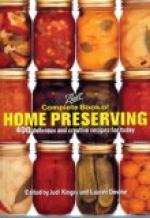Buying bed linen is not so very serious a matter. Drygoods stores offer sheets and pillowcases ready made to fit any sized bed or pillow at prices little, if any, greater than the cost of those made at home. Merchants say that they sell one hundred sheets ready made to one by the yard, which speaks well, not for their goods alone, but for the spirit of housewifely economy which maintains that labor saved is time and strength earned. Moreover, the deluded seeker after bed beauty who wastes her precious hours in hemstitching sheets and pillowcases—cotton ones at that—is a reckless spendthrift, and needs a course in the economics of common sense. Nothing is more desirable than the simple elegance of the plain, broad hem, nor more disheartening than hemstitching which has broken from its moorings while the rest of the sheet is still perfectly good—a way it has. Hem-stitching may answer on linen sheets which are not in constant use, but ordinarily let us have the more profitable plainness. Good sheets are always torn—not cut—and finished with a 2 1/2- or 3-inch hem at the top and an inch hem at the bottom, the finished sheet measuring not less than 2 3/4 yards. There must be ample length to turn back well over the blankets and to tuck in at the foot, for it is a most irritating sensation to waken in the night with the wool tickling one’s toes and scratching one’s chin. Sheets are to be had in varying widths to suit different sized beds.
PRICE AND QUALITY
The 2 3/4-yard length in an average sheet of good quality costs 90 cents for a double bed, 75 cents for a three-quarter bed, and 45 cents for a single bed, with hemstitched sheets of corresponding quality at the same price. It is hardly worth while to pay more than this, while very good sheets are to be had for 75 cents, with a decrease in price as the width decreases. Half-bleach double-bed sheets of good quality cost 85 and 70 cents, and so on, and are more especially for servants’ beds. They are popularly supposed to outwear the bleached, but are somewhat trying bedfellows until whitened.
Plain or hemstitched pillowcases cost from 25 to 75 cents a pair, each additional width raising the price 5 cents. The average or sleeping-size pillow is 22 1/2 by 36 1/2 inches, and calls for a case enough larger to slip on easily, but not loose nor long enough to hang over the sides of the bed. If pillows of different sizes are in use their cases should be numbered.
Bed linen should be firmly woven, with a thread rather coarse than fine. The amount purchased must be regulated by the number of beds to be furnished, allowing three sheets and three pairs of cases to each. The supply can always be easily added to, but if expedient for any reason to buy in large quantities, set apart enough to supply all the beds and keep the rest in reserve, otherwise it will all give out at once. If the housewife is so unfortunately situated that she is forced to make her own bed linen, she will do well to buy her material by the piece—40 to 50 yards. All hems can be run on the machine.




